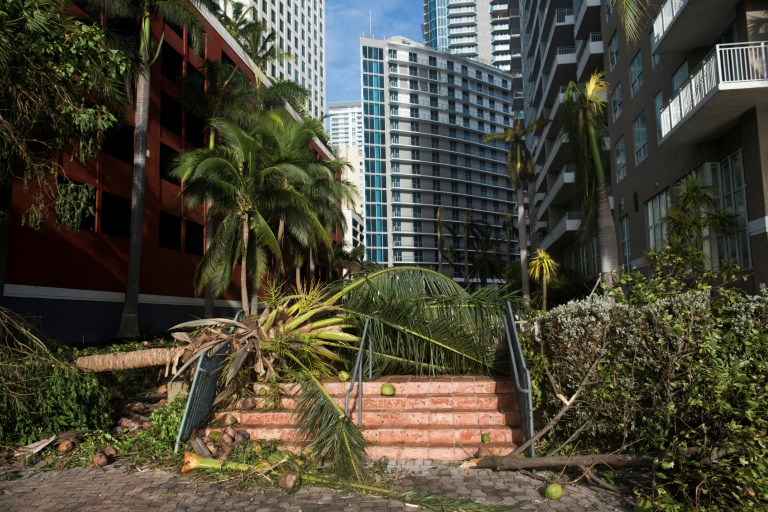Residents of Miami awoke Monday to fallen trees and branches, broken traffic lights, closed roads and sunken yachts.
Despite that, there was widespread relief that the storm surge triggered by Hurricane Irma, which swamped the city’s business district, had not caused the catastrophic damage that had been predicted by meteorologists.
Clean-up teams were out at daybreak to clear the streets of debris, toppled traffic signals and downed trees left behind as the storm moved northwards and the floodwaters receded.
On Sunday, parts of the central business district of Brickell were swamped when the storm surge overwhelmed the sea front and flooded several blocks of high-end hotels, businesses and condo buildings.
The Miami waterfront, as well as the islands that make up the city, are used to flooding because much of the city is low lying and facing rising sea levels.
Some residents refused to follow the evacuation order and were out on the streets Monday, walking dogs and evaluating the damage to their town. Their relief at having weathered the storm was evident.
“If this had been a Category 4 hurricane the whole scenario would have been completely different,” said Bob Lutz, a 62-year-old business owner.
“We wouldn’t have power for weeks, and we just got the power restored this morning. We wouldn’t have provisions for at least a week. This would have been a whole different scene now if it had been a Category 4 or 5. So everybody is glad that didn’t happen.”

A downed tree caused by Hurricane Irma blocks a pedestrian walkway in downtown Miami, Florida, September 11, 2017.
“If we had evacuated, we maybe would have evacuated to Tampa or Naples, which would have been right into the storm,” he noted. “But it was a big surge yesterday, there was a lot of water.”
In Brickell’s marina, yachts and pleasure craft were partially submerged or totally under water.
Irma hit the Florida Keys to the south as a powerful Category 4 hurricane, but was quickly downgraded to a still-dangerous Category 3. By the time it had passed Naples on the Gulf coast, it had been reduced to a tropical storm.
Miami had been geared up to face a potential Category 5 as the storm barrelled across the Caribbean, but in the end was spared the worst as the weather system veered off to the west coast of the panhandle before grinding its way north.
– Curfew –
Nevertheless, the outer bands of the hurricane smacked the city with gusts of 90 miles per hour, triggering sudden tornados on the streets.
“There was a car that had water up above the wheels,” said 53-year-old nurse Estrella Palacios who also stayed put in Brickell. “It was sad to see it like that but we were expecting worse, the news reports were really alarming.”
A man carries a street sign that had fallen due to the winds by Hurricane Irma in Miami, Florida, September 11, 2017.
Miami-Dade’s mayor, Carlos Gimenez, imposed a county-wide curfew from 1900 to 0700 until further notice, noting that 80 percent of the population had no electricity.
Resident of Miami Beach were informed that they would only be allowed to return to their homes to assess the damage if they could show proof of residency, and even then only once the authorities deemed it safe to make the journey. That could be on Tuesday or Wednesday, official said.
Some residents who had stayed on the tourist-friendly barrier island off the coast of mainland Miami told AFP that the streets had been flooded and that the wind had uprooted trees and the area’s trademark palms.
“It’s a show but not a catastrophic event,” said Roberto Cuneo, a 41-year-old resident of Miami Beach who sat tight through the storm. He estimated waters had risen by 30 cm during the storm surge.
The extent of damage to the Florida Keys, which bore the brunt of the hurricane’s fury, was still unclear. Roads leading there were blocked as far north as Homestead, 25 miles from Key Largo, the first in the string of small islands that stretch off Floria’s southern coast and which are connected by road bridges.
Florida Governor Rick Scott flew over the Keys on Monday in a Coast Guard aircraft and was hoping to land with them as they dispatched teams to evaluate the damage.
Download our app